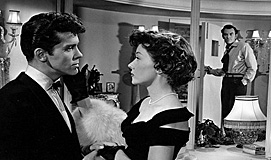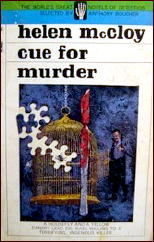Sat 21 Jan 2017
A Movie Review by Dan Stumpf: THE GOOD DIE YOUNG (1954).
Posted by Steve under Crime Films , Reviews[6] Comments
THE GOOD DIE YOUNG. Romulus Films, UK, 1954; United Artists, US, 1955. Laurence Harvey, Gloria Grahame, Richard Basehart, Joan Collins, John Ireland, Stanley Baker, Margaret Leighton and Robert Morley. Screenplay by Vernon Harris and Lewis Gilbert, from a novel by Richard Macaulay. Directed by Lewis Gilbert.
A bit too much fat on this one, but when it gets lean & mean, it’s just about perfect.
Richard Basehart, Stanley Baker and John Ireland star as three men in crisis, each for different reasons: Basehart and Ireland are going through domestic problems, and Baker, who grievously injured his hand in a boxing match, is out of work. What it comes down to is that they all need money.
Laurence Harvey is having domestic problems too, but his are of a different stripe; his rich wife (Margaret Leighton, who married Harvey in real life the next year) is tired of paying his bills while he fools around with other women, and she insists they must make a fresh start in Kenya. So if he wants to stay in London living the life he thinks he deserves, he’d better get rich quick.
Harvey is at his slimy best in this one, projecting love and goodwill when absolutely necessary, but with a sneer never far from his lips. The perfect sociopath, and so well played that when the notion of committing armed robbery comes up, it seems perfectly natural for him. About an hour or so into the film, he convinces the others that everyone’s problems will be solved and no harm done, and the caper is underway.
And a good thing too, because that first hour wasn’t much. Stanley Baker’s back story is pretty involving, and Laurence Harvey has a pleasingly acidic encounter with his father (Robert Morley) but the rest is just Richard Basehart trying to get his wife (Joan Collins) out from under her mother’s domination, and John Ireland kvetching at his unfaithful spouse (Gloria Grahame.) I nearly shut the damnthing off….

…but I’m glad I didn’t because the caper finally gets going, and it’s simply splendid, all fog-bound streets, twisting alleys, noisy train yards, and Laurence Harvey cheerfully shooting down cops, bystanders and his own partners in crime with casual aplomb. It’s handled with a sure feel for pace and tempo by director Gilbert, who did some of the Bond films, and it’s captured with moody fatalism by photographer Jack Asher, who would impart a distinctive look to Hammer’s horror films a few years later. Also, we get that classic feature of the noir film: the mortally wounded protagonist desperately walking toward freedom as he dies.
There’s just one rub: This film was based on a book by Richard Macaulay, but I haven’t been able to find it offered for sale anywhere or even reviewed anyplace. Has anyone ever seen it?

